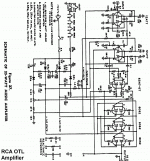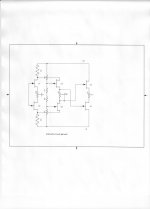Richard is right. Both Charles Hansen and I use very low power supply rejection topologies. We have to make up for this by designing custom, super low noise/distortion power supply buffers to take the nominal DC to a really low noise DC.
This is a strange thing coming from someone who cherishes complimentary symmetry and balanced design. What do you gain with poor PSRR circuits?
Well, that was just one record, and not necessarily their best offering. I have virtually 'fallen in love' with an unknown singer (to me) from listening on a set of quad electrostatics and Electrocompaniet electronics in Oslo, Norway, of a Sheffield direct disc record. That is HOW I could easily verify that these guys from Electro. were on to something.
I gain nothing but the optimum topology for the job at hand.
That output stage is a throwback to things like Futterman OTL.
Here's one, the hot chassis is an added feature. Does anyone know if this predates Kaneda?
Attachments
Last edited:
That output stage is a throwback to things like Futterman OTL.
Here's one, the hot chassis is an added feature. Does anyone know if this predates Kaneda?
If you mean that "practical schematic" that John had shown, it is quite different. There 2 currents were applied to resistors between gates and sources of each particular output device. Here triodes loaded on resistors supply voltage signals to grids of common cathode and common anode stages. Gross imbalance. John's version is much better.
When Yamaha brought out the giant-JFET-output model B1 amplifier (below) they had a good white paper about the output stage drive, but I can't find it online. I'll see if I can figure out a way if anybody's interested.
http://my.coolala.net/upload0713/2010/281/1286557087.gif
Thanks,
Chris
http://my.coolala.net/upload0713/2010/281/1286557087.gif
Thanks,
Chris
When Yamaha brought out the giant-JFET-output model B1 amplifier (below) they had a good white paper about the output stage drive, but I can't find it online. I'll see if I can figure out a way if anybody's interested.
http://my.coolala.net/upload0713/2010/281/1286557087.gif
Thanks,
Chris
I don't see the point, these circuits are bandaids when you can make only one good flavor of device. Topologically you can show the same crossover issues with low quiescient bias as if you had a class A/B output and the PSRR is do-do.
I don't see the point, these circuits are bandaids when you can make only one good flavor of device. Topologically you can show the same crossover issues with low quiescient bias as if you had a class A/B output and the PSRR is do-do.
Sure nuf. Just another Futterman variant. All Julius' children are playin' his licks.
Thanks,
Chris
In any case, some 'successful' designs have lots of potential problems and are not power supply proof, for example. Then we have to go, all out, to make the supplies as clean, low noise, and fast as possible, so they will not add noise or distortion to the main circuit.
In any case, some 'successful' designs have lots of potential problems and are not power supply proof, for example. Then we have to go, all out, to make the supplies as clean, low noise, and fast as possible, so they will not add noise or distortion to the main circuit.
And even with good PSRR you might as well make a nice clean power supply or face some criticism from the market or competitor for not doing your best.
Even better than average power supply rejection is not perfect, especially at high frequencies. While, I can understand that someone may criticize another's design in the audio marketplace, I don't find it normal to do so. There are many 'myths' as to how we actually operate in audio design and development.
Another quiet time, and I hope to once again convey what the goal of hi end audio design is, at least for my colleagues and me.
I keep repeatedly hearing that I am part of some sort of 'conspiracy' to effect people's hearing decisions through propaganda, 'false' advertising, etc.. However, I see very little or no evidence of this in reality, with myself or the majority of my colleagues. Most of us just work to make a successful audio product, often based on our OWN personal opinions of what is important to make it so.
I have made a guideline for myself that I give to my clients to hopefully follow as best as possible. The general principles in this guideline are based on my past experience with making both successful and sometimes, unsuccessful, products. Since my experience goes back 45 years, I have a lot of examples to choose from.
It may seem trivial for me to say what made one of my first independent assignments fail more than 40 years ago. Yet Sony makes the same 'mistake' in one of their latest models, AND I can hear it. Some people cannot learn from others, and they are destined to make the same mistakes. It is an engineering 'trap'.
Now, it has been MY experience that when I deviate significantly from my 'guideline' especially by letting others do a great deal of the layout and construction in their own way with one of my basic designs, that EVEN sticking my name on the design, will NOT make it successful. So much for NAME RECOGNITION.
What about advertising? Well, without any 'advertising', you better have a lot of friends!
Of course, customers have to know that you exist, but that is not necessarily hard core advertising. Often, word of mouth, between audiophiles is enough to get started. A successful review by a known reviewer can give you all the success that you ever need, IF you want to remain a small concern, 'doing what you like to do'.
Of course, many companies take out full page ads in the latest Stereophile or TAS to get themselves introduced. How many people would know about 'Constellation Audio' if they did NOT advertise a bit? The very high expense of these ads reflects also the size of the company. They are usually not a 3 man shop, for example, but at least a small industrial concern. I take these ads with 'a grain of salt' knowing that the actual sonic qualities cannot be expressed in the ad, itself, and you should too.
The bottom line for me, is to tell you to: 'Trust your ears' NOT advertising, measurements, how pretty the case is on the outside, etc. If you are relatively honest with yourself, you will rarely go wrong with this advice. AND if something cheaper or more convenient comes your way and sounds as good as what you have, go for it.
I keep repeatedly hearing that I am part of some sort of 'conspiracy' to effect people's hearing decisions through propaganda, 'false' advertising, etc.. However, I see very little or no evidence of this in reality, with myself or the majority of my colleagues. Most of us just work to make a successful audio product, often based on our OWN personal opinions of what is important to make it so.
I have made a guideline for myself that I give to my clients to hopefully follow as best as possible. The general principles in this guideline are based on my past experience with making both successful and sometimes, unsuccessful, products. Since my experience goes back 45 years, I have a lot of examples to choose from.
It may seem trivial for me to say what made one of my first independent assignments fail more than 40 years ago. Yet Sony makes the same 'mistake' in one of their latest models, AND I can hear it. Some people cannot learn from others, and they are destined to make the same mistakes. It is an engineering 'trap'.
Now, it has been MY experience that when I deviate significantly from my 'guideline' especially by letting others do a great deal of the layout and construction in their own way with one of my basic designs, that EVEN sticking my name on the design, will NOT make it successful. So much for NAME RECOGNITION.
What about advertising? Well, without any 'advertising', you better have a lot of friends!
Of course, customers have to know that you exist, but that is not necessarily hard core advertising. Often, word of mouth, between audiophiles is enough to get started. A successful review by a known reviewer can give you all the success that you ever need, IF you want to remain a small concern, 'doing what you like to do'.
Of course, many companies take out full page ads in the latest Stereophile or TAS to get themselves introduced. How many people would know about 'Constellation Audio' if they did NOT advertise a bit? The very high expense of these ads reflects also the size of the company. They are usually not a 3 man shop, for example, but at least a small industrial concern. I take these ads with 'a grain of salt' knowing that the actual sonic qualities cannot be expressed in the ad, itself, and you should too.
The bottom line for me, is to tell you to: 'Trust your ears' NOT advertising, measurements, how pretty the case is on the outside, etc. If you are relatively honest with yourself, you will rarely go wrong with this advice. AND if something cheaper or more convenient comes your way and sounds as good as what you have, go for it.
Another quiet time
The calm before the storm?
Gentlemen, Ladies too,
No disrespect intended to anyone but is there a plan or consensus for how to build this preamp. I am new here and it looks like to get up to speed on this thread I would have to read 54,000 (seriously) posts.
I like what the part one posts said about his design but 54,000 posts later I don't see a plan.
Did anyone build this preamp?
What are your thoughts?
Advice?
Thanks in advance for some input.
Mike
No disrespect intended to anyone but is there a plan or consensus for how to build this preamp. I am new here and it looks like to get up to speed on this thread I would have to read 54,000 (seriously) posts.
I like what the part one posts said about his design but 54,000 posts later I don't see a plan.
Did anyone build this preamp?
What are your thoughts?
Advice?
Thanks in advance for some input.
Mike
- Status
- Not open for further replies.
- Home
- Member Areas
- The Lounge
- John Curl's Blowtorch preamplifier part II


